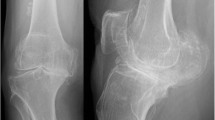Abstract
Use of navigation systems has recently been introduced in total knee arthroplasty (TKA) to achieve more reliable prosthetic alignment. In the sagittal plane, there are two important requirements for navigation systems: (1) perpendicular cut to the femoral mechanical axis and (2) prevention of notching of anterior femoral cortex. These two requirements, however, may conflict. The angles between the line of the anterior femoral cortex and four sagittal femoral mechanical axes for navigation systems using radiographs of the entire lower extremity, while standing were measured and compared. These four sagittal axes simulated on the radiographs in navigation systems were in extension relative to the line of the anterior femoral cortex in 40–85% of cases in male and 65–100% in elderly female. The present study showed that navigation systems have the potential risk for notching of anterior femoral cortex.



Similar content being viewed by others
References
Bathis H, Perlick L, Tingart M et al (2004) Alignment in total knee arthroplasty. A comparison of computer-assisted surgery with the conventional technique. J Bone Joint Surg Br 86:682–687
Berger RA, Rubash HE, Seel MJ et al (1993) Determining the rotational alignment of the femoral component in total knee arthroplasty using the epicondylar axis. Clin Orthop Relat Res 286:40–47
Bland JM, Altman DG (1986) Statistical methods for assessing agreement between two methods of clinical measurement. Lancet 1(8476):307–310
Bolognesi M, Hofmann A (2005) Computer navigation versus standard instrumentation for TKA: a single-surgeon experience. Clin Orthop Relat Res 440:162–169
Bonutti PM, Dethmers DA, McGrath MS et al (2008) Navigation did not improve the precision of minimally invasive knee arthroplasty. Clin Orthop Relat Res 466:2730–2735
Chauhan SK, Clark GW, Lloyd S et al (2004) Computer-assisted total knee replacement. A controlled cadaver study using a multi-parameter quantitative CT assessment of alignment (the Perth CT protocol). J Bone Joint Surg Br 86:818–823
Clarke HD, Hentz JG (2008) Restoration of femoral anatomy in TKA with unisex and gender-specific components. Clin Orthop Relat Res 466:2711–2716
Haaker RG, Stockheim M, Kamp M et al (2005) Computer-assisted navigation increases precision of component placement in total knee arthroplasty. Clin Orthop Relat Res 433:152–159
Hart R, Janecek M, Cizmár I et al (2006) Minimally invasive and navigated implantation for total knee arthroplasty: X-ray analysis and early clinical results. Orthopade 35:552–557
Jeffery RS, Morris RW, Denham RA (1991) Coronal alignment after total knee replacement. J Bone Joint Surg Br 73:709–714
Jenny JY, Clemens U, Kohler S et al (2005) Consistency of implantation of a total knee arthroplasty with a non-image-based navigation system: a case–control study of 235 cases compared with 235 conventionally implanted prostheses. J Arthroplasty 20:832–839
Lesh ML, Schneider DJ, Deol G et al (2000) The consequences of anterior femoral notching in total knee arthroplasty. A biomechanical study. J Bone Joint Surg Am 82:1096–1101
Lützner J, Krummenauer F, Wolf C et al (2008) Computer-assisted and conventional total knee replacement: a comparative, prospective, randomised study with radiological and CT evaluation. J Bone Joint Surg Br 90:1039–1044
Middleton FR, Palmer SH (2007) How accurate is Whiteside’s line as a reference axis in total knee arthroplasty? Knee 14:204–207
Minoda Y, Kobayashi A, Iwaki H et al (2008) Sagittal alignment of the lower extremity while standing in Japanese male. Arch Orthop Trauma Surg 128:435–442
Minoda Y, Kobayashi A, Iwaki H et al (2009) TKA sagittal alignment with navigation systems and conventional techniques vary only a few degrees. Clin Orthop Relat Res 467:1000–1006
Mizu-uchi H, Matsuda S, Miura H et al (2008) The evaluation of post-operative alignment in total knee replacement using a CT-based navigation system. J Bone Joint Surg Br 90:1025–1031
Oswald MH, Jakob RP, Schneider E et al (1993) Radiological analysis of normal axial alignment of femur and tibia in view of total knee arthroplasty. J Arthroplasty 8:419–426
Sparmann M, Wolke B, Czupalla H et al (2003) Positioning of total knee arthroplasty with and without navigation support. A prospective, randomised study. J Bone Joint Surg Br 85:830–835
Stulberg SD (2003) How accurate is current TKR instrumentation? Clin Orthop Relat Res 416:177–184
Tew M, Waugh W (1985) Tibiofemoral alignment and the results of knee replacement. J Bone Joint Surg Br 67:551–556
Tria AJ Jr (2006) The evolving role of navigation in minimally invasive total knee arthroplasty. Am J Orthop 35(7 Suppl):18–22
Wasielewski RC, Galante JO, Leighty RM et al (1994) Wear patterns on retrieved polyethylene tibial inserts and their relationship to technical considerations during total knee arthroplasty. Clin Orthop Relat Res 299:31–43
Zalzal P, Backstein D, Gross AE et al (2006) Notching of the anterior femoral cortex during total knee arthroplasty characteristics that increase local stresses. J Arthroplasty 21:737–743
Author information
Authors and Affiliations
Corresponding author
Rights and permissions
About this article
Cite this article
Minoda, Y., Kobayashi, A., Iwaki, H. et al. The risk of notching the anterior femoral cortex with the use of navigation systems in total knee arthroplasty. Knee Surg Sports Traumatol Arthrosc 18, 718–722 (2010). https://doi.org/10.1007/s00167-009-0927-5
Received:
Accepted:
Published:
Issue Date:
DOI: https://doi.org/10.1007/s00167-009-0927-5



